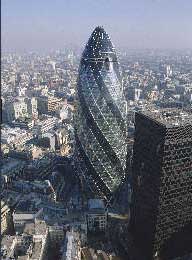
30 St Mary Axe wins the 2004 Stirling Prize
www.fosterandpartners.com/InternetSite/html/News.asp?ID=163
W tym
roku nagrodę w wysokości 37 tys. dolarów otrzymał Foster
and Partners za budynek zaprojektowany w Londynie dla
szwajcarskiej firmy ubezpieczeniowej Swiss Re. Nagrodzony
40-to piętrowy budynek ma szanse zostać rozpoznawalnym
elementem Londynu. Posiada on najnowocześniejsze rozwiązania
i udogodnienia.
Dużo innowacyjnych
pomysłów związanych z wentylacją budynku, inteligentnym
wewnętrznym podziałem przestrzeni.
Budynek ma
niestety ograniczony dostęp dla zwiedzających - z góry
opłacone sporadyczne wycieczki w obszar szczytu budynku,
gdzie obecnie jest restauracja i apartamenty na miarę
XXI wieku.
Chociaż werdykt
zapadł jednomyślnie to pięć pozostałych finałowych projektów
brytyjskiej architektury było na najwyższym poziomie:
- Kunsthaus
w Graz, proj. Peter Cook i Colin Fournier,
- Spire w
Dublinie, proj. Ian Ritchie Architekts,
- Imperial
War Museum w Manchesterze, proj. Studio Daniel Libeskind,
- Phoenix
Initiatywe w Coventry proj. MacCormac Jamieson Prichard,
- Business
Academy Bexley, proj. Foster and Partners.
info: tekst ronet.pl
tekst oryginalny:
Foster and Partners are delighted to announce
that the Swiss Re Headquarters at 30 St Mary Axe,popularly
known as the 'Gherkin,' has won the Stirling Prize for 2004.
Named after the British architect Sir James Stirling (1926-1992),
the Prize is awarded by the Royal Institute of Architects
in conjunction with The Architects' Journal to "the
building that has made the greatest contribution to British
Architecture in the past year." For the first time
in the nine-year history of the award, the judges were unanimous
in their decision.
Developed on the precedents of 'green' architecture
for which the practice is renowned, the Foster designed
30 St Mary Axe is the capital's first ecologically progressive
skyscraper, and its uncompromising quality has set a benchmark
for an emerging generation of tall buildings. Noting that
the tower's iconic form has become synonymous with London,
the judges' citation praised how "the level of discrimination,
careful detailing, and power of the structure combine to
sustain the initial impression that this is a memorable
building of international standing."
Accepting the award from George Ferguson,
the President of the Royal Institute of British Architects,
Norman Foster thanked the jury for acknowledging the significance
of its design. "Winning the Stirling Prize is a great
honour," he stated, "It is a credit to the commitment
and vision of an exceptional client and a talented team.
30 St Mary Axe is an embodiment of the core values that
we have championed for more than thirty years: values about
humanising the workplace, conserving energy, democratising
the way people communicate within a building, and the way
that building relates to the urban realm."
Foster and Partners were in the unique position
of having two projects - 30 St May Axe, and the Bexley Business
Academy - selected as finalists from among sixty-three award-winning
buildings. The other shortlisted finalists were: Peter Cook
and Colin Fournier, Kunsthaus, Graz; Ian Ritchie Architects,
The Spire, Dublin; Studio Daniel Libeskind, Imperial War
Museum North, Manchester; and MacCormac Jamieson Prichard,
Phoenix Initiative, Coventry. The Stirling Prize judges
were: Isabel Allen, Editor of The Architects' Journal; Antony
Gormley, sculptor; Deborah Bull, Dancer and Artistic Director
of the Royal Opera House 2; Ted Cullinan, the principal
of Edward Cullinan Architects; and Francine Houben, Architect
Director, Mecanoo.
The award was presented during a nationally
televised ceremony at the Old Billingsgate Market, London.
This is the second time that Foster and Partners have been
awarded the prestigious Stirling Prize; the first being
for the American Air Museum at Duxford in 1998.
|